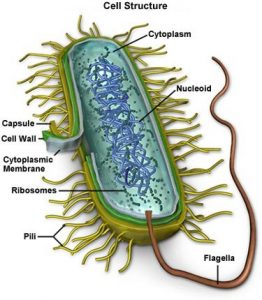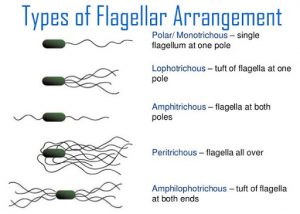BACTERIA
- Bacteria are single-celled organisms and are microscopic in nature.
- They usually live a number of micrometers long and exist along in communities of millions.
- They have a simple life- forms but are also known to be a major cause of disease.
- A gram of soil generally contains around forty million microorganism cells. A milliliter of water typically holds regarding a million microorganism cells.
- The earth is estimated to carry a minimum of five nonillion microorganisms, and the earth’s biomass is believed to be created from a microorganism.
FORMS OF BACTERIA.
There are many alternative varieties of microorganisms. a technique of classifying them is by form. There are 3 basic shapes.
- Spherical: microorganism formed sort of a ball are known as cocci, and one microorganism could be a true bacteria. Examples embody the eubacterium cluster, liable for “strep throat.”
- Rod-shaped: These are referred to as bacilli (singular bacillus). Some rod-shaped microorganisms are snakelike. These are referred to as true bacteria. samples of rod-shaped microorganisms include Bacillus anthracis (B. anthracis), or anthrax.
- Spiral: These are referred to as spirilla (singular spirillus). If their coil is incredibly tight they’re referred to as spirochetes. Leptospirosis, Lyme illness, and syphilis are caused by a microorganism of this form.
There are several variations among every form.

BODY STRUCTURE
Bacterial cells are totally different from plant and animal cells. Microorganisms are prokaryotes, which implies they have no nucleus.

A microorganism cell includes:
- Capsule: A layer found on the surface of the plasma membrane in some microorganisms.
- Cell wall: A layer of a chemical compound known as peptidoglycan is present in the cell wall. The plasma membrane offers the microorganism its form. it’s placed outside the cell wall.
- Plasma membrane: Found among the plasma membrane, this generates energy and transports chemicals. The membrane is leaky, which implies that substances will meet up with it. The plasma membrane is thicker in some microorganisms, known as Gram-positive microorganisms.
- Cytoplasm: A gelatin-like substance within the cell wall that contains genetic material and ribosomes.
- DNA: This contains all the genetic directions employed in the event and performance of the microorganism. it’s placed within the protoplasm.
- Ribosomes: this is often wherever proteins are created or synthesized. Ribosomes are complicated particles created from RNA-rich granules.
- Flagellum: This is often used for movement, to propel some varieties of microorganisms. The types of flagella in bacteria are monotrichous (single flagellum at one pole. ), amphitrichous (flagella at both poles), lophotrichous (tuft of flagella at one pole), peritrichous (flagella all over) and Amphilophotrichous (tuft of flagella at both ends)

- Pili: These hair-like appendages on the surface of the cell permit it to stay to surfaces and transfer genetic material to different cells. this will contribute to the unfold of ill health in humans.
NUTRITION
Bacteria feed-in alternative ways.
- The heterotrophic bacterium, or heterotrophs, get their energy through consuming organic carbon. Most absorb dead organic material, like moldering flesh.
- A number of these parasitic bacteria kill their host, whereas others facilitate them.
- Autotrophic bacterium (or simply autotrophs) build their own food, either through either: photosynthesis, exploitation daylight, water, and dioxide, or chemosynthesis, exploitation dioxide, water, and chemicals like ammonia, nitrogen, sulfur, and others
- Bacteria that use chemical change are referred to as photoautotrophs. Some types, as an example true bacteria, produce oxygen. These most likely contend a significant role in making the oxygen within the earth’s atmosphere. Others, like heliobacteria, don’t produce oxygen.
- Those that use synthesis are called chemoautotrophs. These bacteria are usually found in ocean vents and within the roots of legumes, like alfalfa, clover, peas, beans, lentils, and peanuts.
HABITATS
- Bacteria are often found in soil, water, plants, animals, radioactive material, deep within the earth’s crust, arctic ice and glaciers, and hot springs.
- There is a bacterium within the layer, between 6 and thirty miles up within the atmosphere, and within the ocean depths, down to 32,800 feet or 10,000 meters deep.
- Aerobes, or aerobic bacterium, will solely grow wherever there’s oxygen.
- Some varieties will cause issues for the human setting, like corrosion, fouling, issues with water clarity, and dangerous smells.
- Anaerobes, or anaerobic bacterium, will solely grow wherever there’s no Oxygen. In humans, this is often principally within the channel.
- This will additionally cause gas, gangrene, tetanus, botulism, and most dental infections.
- Facultative anaerobes, or facultative anaerobic bacterium, will live either with or while not oxygen, however, they like environments wherever there’s oxygen.
- They’re principally found in soil, water, vegetation, and a few traditional flora of humans and animals. Examples include Salmonella.
- Mesophiles, or mesophilic bacterium, are the bacterium liable for most human infections. They thrive in moderate temperatures, around 37°C. this is often the temperature of the material body.
- Examples include Listeria monocytogenes, Pseudomonas maltophilia, eubacterium Novellus, staphylococcus aureus, true bacteria pyrogens, true bacteria pneumonia, enteric bacteria coli, and Clostridium kluyveri.
- The human microorganism, or gut microbiome, contains helpful mesophilic bacterium, like dietary Lactobacillus acidophilus.
- Extremophiles, or extremophiles’ bacterium, will stand up to conditions thought of too extreme for many life forms.
- Thermophiles will sleep in high temperatures, up to 75 to 80°C, and hyperthermophiles will survive in temperatures up to 113°C.
- Deep within the ocean, bacterium sleeps in darkness by thermal vents, wherever each temperature and pressure are high.
- They create their own food by oxidizing sulfur that comes from deep within the world.
- Other extremophiles include halophiles that are found solely in a very salty environment, acidophiles where a number of organisms that sleep in environments as acidic as pH scale, alkaliphiles where organisms living in alkaline environments up to pH scale 10.5, psychrophiles that are found in cold temperatures, as an example, in glaciers.
- Extremophiles will survive wherever no different organism can.
REPRODUCTION AND TRANSFORMATION.
Bacteria could reproduce and alter exploitation the subsequent methods:
- Binary fission: It is associated degree agamic kind of reproduction, during which a cell continues to grow till a replacement semipermeable membrane grows through the middle, forming 2 cells. These separate, creating 2 cells with identical genetic material.
- Transfer of genetic material: Cells acquire new genetic material through processes called conjugation, transformation, or transduction. These processes will build bacterium stronger and additionally able to resist threats, such as antibiotic medication.
- Spores: once some forms of the bacterium are low on resources, they will type spores. Spores hold the organism’s deoxyribonucleic acid material and contain the enzymes required for germination. They’re terribly immune to environmental stresses. The spores will stay inactive for hundreds of years until the proper conditions occur. Then they will activate and become bacterium.

- Spores will survive through periods of environmental stress, as well as ultraviolet (UV) and electromagnetic wave, desiccation, starvation, chemical exposure, and extremes of temperature.
- Some bacterium produces endospores, or internal spores, whereas others produce exospores, that are discharged outside. These are celebrated as cysts.
- Clostridium is an example of an endospore-forming microorganism. There are regarding a hundred species of Clostridium, including Clostridium botulinum (C. botulinum) or gastrointestinal disorder, liable for a doubtless fatal kind of food poisoning, and Clostridium difficile (C. Difficile), that causes rubor and different enteric issues.
References
https://www.medicalnewstoday.com/articles/157973
https://www.ncbi.nlm.nih.gov/books/NBK8120/#:~:text=Bacteria%20are%20single%2Dcelled%20microorganisms,are%20sophisticated%20and%20highly%20adaptable.
https://www.researchgate.net/figure/Structure-of-bacterial-cell_fig1_277344628
